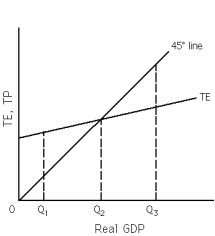A) What do efficiency wage models imply?
B) What do classical economists say?
C) What is the central tenet of Say's law?
D) What did John Maynard Keynes say was the reason for inflexible wages?
E) none of the above
G) A) and B)
Correct Answer

verified
Correct Answer
verified
Multiple Choice
The more firms that pay efficiency wages,the
A) more likely the economy will get stuck in a recessionary gap.
B) less likely the economy will get stuck in a recessionary gap.
C) more likely the economy will get stuck in an inflationary gap.
D) more likely (over time) the economy will produce Natural Real GDP.
E) b and c
G) C) and E)
Correct Answer

verified
Correct Answer
verified
Multiple Choice
Exhibit 10-1
 -Refer to Exhibit 10-1.Equilibrium Real GDP occurs at
-Refer to Exhibit 10-1.Equilibrium Real GDP occurs at
A) Q1.
B) Q2.
C) Q3.
D) Q1 and Q3.
E) none of the above
G) B) and D)
Correct Answer

verified
Correct Answer
verified
Multiple Choice
Which statement is consistent with what Keynes believed about consumption and disposable income?
A) Consumption depends upon disposable income and falls as disposable income rises.
B) Consumption rises by the same amount as disposable income rises.
C) Consumption rises by less than disposable income rises.
D) Disposable income depends upon consumption.
F) A) and B)
Correct Answer

verified
Correct Answer
verified
Multiple Choice
Exhibit 10-3
 -Refer to Exhibit 10-3.When disposable income equals $2,000,saving equals
-Refer to Exhibit 10-3.When disposable income equals $2,000,saving equals
A) -$20.
B) -$40.
C) 0.
D) $40.
E) $20.
G) B) and C)
Correct Answer

verified
Correct Answer
verified
True/False
Keynes asserted that investment is more responsive to business expectations,technological changes and innovation,than to changes in interest rates.
B) False
Correct Answer

verified
Correct Answer
verified
Multiple Choice
Which of the following is true?
A) If MPC = 0.50, then the multiplier is 2.00.
B) If MPC = 0.82, then the multiplier is 1.25.
C) If MPS = 0.35, then the multiplier is 2.86.
D) If MPC = 0.97, then the multiplier is 3.33.
E) a and c
G) A) and C)
Correct Answer

verified
Correct Answer
verified
Multiple Choice
If autonomous consumption rises,the TE curve shifts __________,the marginal propensity to consume __________,and the TP curve __________.
A) upward; rises; shifts downward
B) upward; remains unchanged; remains unchanged
C) downward; rises; remains unchanged
D) upward; remains unchanged; shifts downward
E) none of the above
G) A) and E)
Correct Answer

verified
Correct Answer
verified
Multiple Choice
In the simple Keynesian model,there are three simplifying assumptions. Among these assumptions is:
A) the price level is flexible
B) no foreign sector
C) the price level is constant until the economy reaches its full-employment level
D) the money supply always rises
E) b and c
G) C) and D)
Correct Answer

verified
Correct Answer
verified
Multiple Choice
Autonomous consumption is
A) the change in consumption that results as a person's (or nation's) income increases or decreases.
B) that portion of total consumption that is dependent upon the level of income.
C) the steady increase in the consumption of goods and services that automatically occurs as a person grows from a child to an adult.
D) that portion of total consumption that is independent of the level of income.
F) B) and D)
Correct Answer

verified
Correct Answer
verified
Multiple Choice
John Maynard Keynes was the son of
A) one of the first female students to attend Cambridge University.
B) Russian ballerina Lydia Lopokova.
C) the mayor of London.
D) an eminent economist.
E) a and d
G) A) and B)
Correct Answer

verified
Correct Answer
verified
Multiple Choice
Keynes believed that investment is
A) dependent on a number of factors, including business expectations.
B) mainly determined by changes in interest rates.
C) unrelated to business expectations.
D) related to business expectations only during recessionary periods.
F) A) and B)
Correct Answer

verified
Correct Answer
verified
Multiple Choice
The classical economists believed __________ determined savings,while Keynes said it was __________.
A) interest rates; income
B) income; investment
C) investment; interest rates
D) interest rates; investment
F) A) and C)
Correct Answer

verified
Correct Answer
verified
True/False
Many economists argue that the labor market may take a long time for wages to adjust to new equilibrium level.
B) False
Correct Answer

verified
Correct Answer
verified
Multiple Choice
The horizontal investment curve used to derive the TE curve means investment is
A) directly related to Real GDP.
B) indirectly related to Real GDP.
C) independent of Real GDP.
D) sometimes directly and sometimes indirectly related to Real GDP, depending upon whether it is planned capital or planned inventory investment.
F) A) and D)
Correct Answer

verified
Correct Answer
verified
Multiple Choice
Exhibit 10-9
 -Refer to Exhibit 10-9.What is the value of the marginal propensity to consume (MPC) that would correctly fill in blank (G) and the value of the multiplier that would correctly fill in blank (H) ?
-Refer to Exhibit 10-9.What is the value of the marginal propensity to consume (MPC) that would correctly fill in blank (G) and the value of the multiplier that would correctly fill in blank (H) ?
A) 0.80; 20
B) 0.80; 5
C) 0.20; 0.80
D) 0.50; 0.50
E) There is not enough information given to answer this question.
G) C) and D)
Correct Answer

verified
Correct Answer
verified
Multiple Choice
How does the classical position on saving differ from Keynes's position?
A) Classical position: people save more at lower interest rates. Keynes's position: people save less at lower interest rates.
B) Classical position: changes in the interest rate are irrelevant to saving decisions. Keynes's position: saving is directly related to the interest rate.
C) Classical position: saving is directly related to the interest rate. Keynes's position: at times, saving may be inversely related to the interest rate.
D) Classical position: saving can be inversely related to the interest rate. Keynes's position: consumption rises as saving rises.
E) none of the above
G) B) and C)
Correct Answer

verified
Correct Answer
verified
Multiple Choice
For Say's law to hold in a money economy,
A) funds invested must give rise to an equal amount of funds spent.
B) funds saved must give rise to an equal amount of funds invested.
C) funds spent must give rise to an equal amount of output produced.
D) interest rates must fall when saving decreases.
E) b and c
G) All of the above
Correct Answer

verified
Correct Answer
verified
Multiple Choice
Exhibit 10-8
 -Refer to Exhibit 10-8.The marginal propensity to save (MPS) is
-Refer to Exhibit 10-8.The marginal propensity to save (MPS) is
A) 0.90.
B) 0.10.
C) 0.75.
D) 0.25.
E) 4.00.
G) C) and E)
Correct Answer

verified
Correct Answer
verified
Multiple Choice
Exhibit 10-9
 -Refer to Exhibit 10-9.What is the value of the marginal propensity to save (MPS) that would correctly fill in blank (A) and the multiplier that would correctly fill in blank (B) ?
-Refer to Exhibit 10-9.What is the value of the marginal propensity to save (MPS) that would correctly fill in blank (A) and the multiplier that would correctly fill in blank (B) ?
A) 0.20; 5
B) 0.08; 8
C) 0.08; 12.5
D) 0.05; 0.95
F) B) and C)
Correct Answer

verified
Correct Answer
verified
Showing 61 - 80 of 198
Related Exams